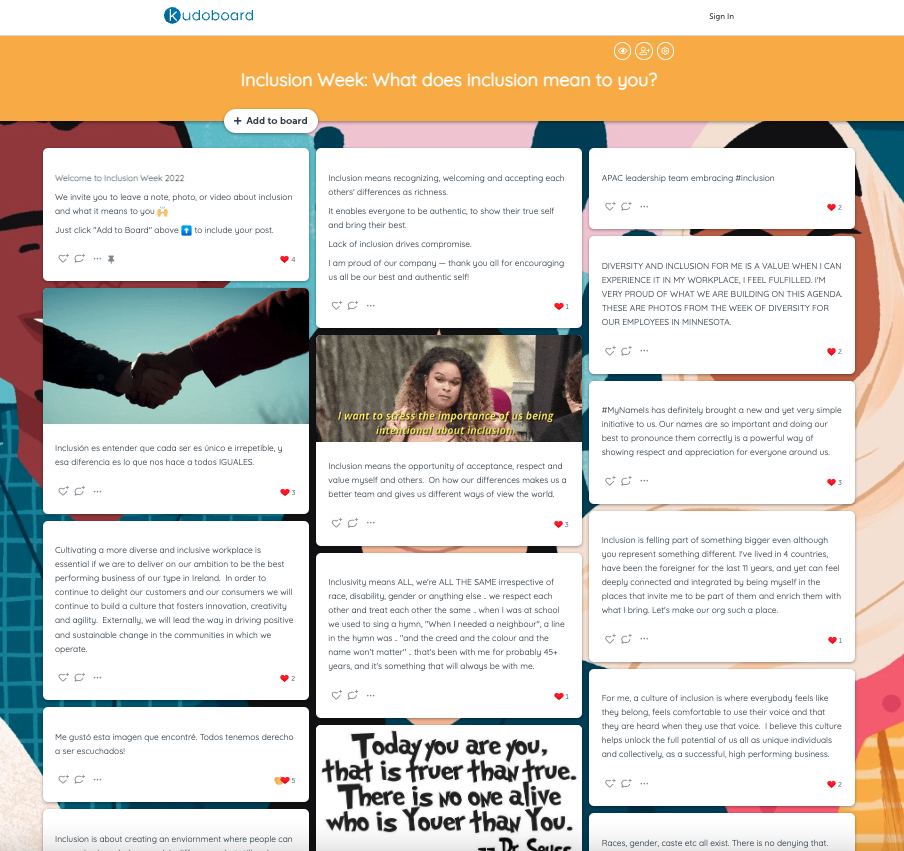The workplace is changing—as are the expectations of employees worldwide. Today, your team members are looking for a flexible and inclusive workplace that honors their whole identity and compensates them fairly. What they want is diversity, equity, and inclusion for all groups in a hybrid workplace. Many companies are playing catch-up with these demands, so let’s get into what it means and how you can use it to better your workplace.
What is DEI?
DEI stands for Diversity, Equity, and Inclusion. DEI refers to initiatives, policies, and practices that make a workplace more diverse, equitable, and inclusive for people of all backgrounds.
Diversity: a range of differences in race, gender, sexual orientation, ethnicity, religion, ability, political affiliation, and socio-economic status.
Equity: access for all groups and individuals, with no partiality or injustice.
Inclusion: an inviting environment where all can be heard, welcomed, and celebrated.
DEI initiatives or goals are those created by a company with the intent of diversifying the workplace and ensuring equity for all groups.
Check out an example Inclusion Week board here.

Why does DEI matter?
A workplace lacking diversity, equity, and inclusion is one in which productivity and perspectives are lost. Studies have shown that teams of more diverse composition (including women, ethnic minorities, varied ages, ability levels, etc.) produce better and more thoughtful solutions to problems than homogenous groups—and we mean 87% more effective.
A commitment to diversity and inclusion sends a strong message to your existing employees as well as potential hires: we are a safe place for all individuals. You will attract and retain better talent, produce better outcomes, and prevent problems with toxic company culture.
Questions to Ask About your DEI Goals in a Hybrid Workplace
The switch to hybrid working environments can affect your diversity, equity, and inclusion in unexpected ways. In order to protect your workplace, you will need to think deeply about the ways your employees will be impacted and the types of policies you may need to develop to meet new needs. It can be helpful to start with the following questions:
- Which groups or individuals will face challenges switching to a hybrid work model? How can we support them?
- How can we improve access for all employees in remote or hybrid roles?
- What biases exist in our workplace? How will biases impact employees in hybrid work?
- Who is spending more time in the office and who is working from home more?
- Who decides when employees can work remotely or from the office?
- What correlations do we see between where employees work and employee engagement or retention? (Note that this might be different for individual employees.)
- Are remote employees managed differently based on where they work? Should they be?
Now, let’s take a look at five positive ways that hybrid work can accelerate DEI goals.

5 Ways Hybrid Work Can Accelerate DEI Goals
If you’ve already set DEI goals for your company, you can use these targets to align your workplace with your goals. If you don’t have DEI goals, these can be a great starting point.
1. Eliminating social bias
Social bias is real, and it can affect our workplaces in a significant way. A primarily white workplace can feel isolating for employees of color. A religious minority may feel misunderstood or left out. Members of the LGBTQ+ community can grow quickly exhausted by the difference in treatment or feel the need to hide or explain their identity constantly. Hybrid work can vastly improve the workplace for these groups, as social bias grows in the margins of social interactions—which are limited and more intentional in a hybrid working environment.
According to a McKinsey survey, LGBQ+ employees were 13 percent more likely to prefer hybrid work than cisgender heterosexual colleagues.
2. Eliminating location barriers
Arguably the best outcome of the COVID-19 pandemic was the shift to remote work, even if it was only temporary for some companies. This shift forced many companies to redefine their hiring requirements, such as location. In the past, your company was limited to qualified employees within commuting distance of your physical workplace. Not only did you miss out on fantastic employees who lived beyond this limited range, but you were also limited to the ethnic and cultural influences local to your area.
Hybrid work allows you to access a greater pool of diverse candidates, which can help you to bring a larger range of perspectives. You can consider and hire employees who fit into untapped categories of diversity, socioeconomic opportunity, and life experience that you might never find within the narrow scope of your geographic location.

3. Greater job access for women
Despite important gains, women worldwide are still assuming the lion’s share of childcare and housework. There is a substantial gap in pay and leadership when it comes to women in the workplace, and it’s hurting everyone—your company included. Hybrid work is one way that women are able to level the playing field. A traditional 9-to-5 can be difficult for moms trying to juggle school pickup or manage infant care, but hybrid working allows for women to more easily balance work and family (and of course, it helps working dads as well!).
Hybrid working can help you attract smart, qualified, and underemployed women who need more flexible working options.
4. Improved accessibility for employees with disabilities
People with disabilities make up 15% of the global population.
The Americans with Disabilities Act of 1990 created a baseline for accessibility in the workplace, making it easier for disabled employees to successfully apply, obtain, and perform their jobs. However, this doesn’t mean it’s always a comfortable and productive environment. For employees with physical, mental, or emotional disabilities, a rigid and in-person working environment can be impossible at times.
Hybrid work allows each employee to create an environment and a hybrid working schedule that allows them to shine. When your company offers flexible hybrid working, you’re signaling an environment that can be catered to the needs of employees with disabilities and you’ll get the very best from these talented employees.
5. Minimized visual bias
It’s an unfortunate reality that visual bias is real in the modern workplace. Tall people are perceived as more capable than short ones, while larger bodies can be judged as less intelligent as we associate intelligence and leadership with more physically fit bodies (although there are no concrete reasons to do so). Visual bias based on attractiveness, body type, ethnic and racial features, and other physical traits can creep into our business dealings and negatively impact our actions—not to mention making our colleagues uncomfortable.
When employees are allowed to work remotely or choose the times they work in office, we can decrease much of that visual bias. People don’t need to rely on their physical presence to positively impact their chances for promotion, or worry that they’re being unfairly labeled due to the way they look.
6 Challenges to DEI Goals in Hybrid Workplaces
We’re excited about the ways that hybrid work can help further DEI initiatives, but it would be irresponsible to ignore any possible challenges that we might face while trying to further our DEI goals in a hybrid workplace. Here are 6 challenges that your company might face as you navigate hybrid work and DEI initiatives.
1. Unequal leadership exposure
Working mothers and those who choose hybrid work for more flexibility may face bias when they choose a path different from the “ideal worker.”
The most prevalent challenge of hybrid work is found in who shows up in the office. Leadership is usually more likely to spend time in the physical workplace. Any employees who opt to attend the office for work will have additional exposure to leadership. Simply being around the leadership team or your direct manager can have a positive impact on your career, even when it’s informal (like grabbing lunch or chatting in the breakroom).
While not inherently damaging or problematic, it is a concern to watch carefully. Are those who choose to work from home being given as much exposure to leadership? Are there unfair advantages given to those who are able to spend more time with leadership in the office?
2. Proximity bias
In a similar vein, we need to talk about proximity bias. Proximity bias is when you’re more inclined to choose, like, or listen to someone/something because you’re close to or around them more often. People in the office could be seen as more trustworthy—not because they choose to come in, but just because you spend more time with them. You grow more attached or comfortable with someone when you’re around them more, and you could be developing a bias that makes you less open to hearing ideas or making choices outside the group you see each day.
It’s important to remember that employees you don’t see and don’t interact with are also doing critical work for the company, and you may need to add compensatory meetings or facetime to ensure that the employees you AREN’T seeing regularly are still getting acknowledged.
3. Speaking equality
Speaking equality is the balanced attention to speaking voices within groups. Ensuring speaking equality is a challenge no matter where your group is gathered—in person, online, or in a hybrid mix. Unbalanced speaking equality means that many voices are not heard, not heard in full, or opt for silence because there isn’t space for them to speak. In these situations, good ideas are lost and helpful criticism is silenced in a way that hurts the company AND employees.
For hybrid working environments, those in-person may be given better opportunities for speaking. You may also find that online attendees have difficulty inserting themselves into the conversations, or are unable to “read the room.” To ensure speaking equality in a hybrid work environment you may want to consider the following:
- Rotating who “runs” the meetings
- Give everyone a chance to air their opinions in each meeting
- Create norms for raising your hand or other methods for indicating your desire to speak
- Educate your teams about speaking equality and problem-solve when issues arise (such as interrupting)

4. Racial, gender, and ability minorities self-select out
“If employees of color report a greater sense of well-being when they spend more time out of the office and safe from microaggressions, you might start to see situations where employees of color sacrifice promotions in favor of personal wellbeing by working remotely.”
HBR
Hybrid work has proven especially popular among minority groups. This is great news for hybrid companies, as their pool of potential interested employees is large and they’re likely to attract diverse and capable talent. However, it can also create a challenge. You may be able to hire a more diverse group of talent, but if they continue to feel more comfortable with remote or hybrid work, you run the risk of losing their important contributions within groups.
97% of Black knowledge workers prefer remote or hybrid work, compared to 79% of their white colleagues.
Your DEI initiatives don’t stop with hiring. In order to become a safe, equitable, and inclusive workplace, your DEI initiatives need to make everyone feel more comfortable and empowered throughout their work life. Your employees should feel comfortable coming into the office, participating in all types of work meetings, and being their complete selves with their coworkers.
5. Difficulty expressing empathy
We’re willing to bet that most managers navigating the switch to remote and/or hybrid work will agree that managing is simply different and requires more intentional work. One of the more difficult aspects of management (and general co-working), is showing empathy. Empathy is key to a healthy workplace and management relationships, but it’s harder to develop and express empathy virtually. It’s more natural to feel empathy and connection with people we’re in front of, and who we see every day.
This challenge is easy to overcome, so long as you are aware of the challenge and take steps to meet it. Empathy begins with truly knowing your employees and caring for them. You can no longer rely on breakroom chats or everyday exposure to develop those relationships—it has to be intentional. Managers may need to schedule more regular one-on-ones and dedicate time to non-work talk to ensure that empathy is nurtured and communicated.
6. Slower compensation progress
One of the more troubling realities we’ve found while researching hybrid work is the delay in the promotion cycle. Unfortunately, remote or hybrid workers are experiencing a slower compensation progression (meaning they’re getting raises at a slower pace). You can combat this by codifying a regular compensation review cycle and training management to speak openly with their employees about their promotion goals.
How to Improve Your DEI Initiatives In Hybrid Work
The most important thing you can do to ensure healthy DEI in your hybrid workplace is to be cognizant of the ways that hybrid work is impacting your employees–ALL of your employees. Be open to the reality that hybrid work can affect individuals differently and that it may be difficult for individuals to articulate their concerns. Here are a few ways to improve your DEI initiatives and circumvent problems:
- Create a regular cadence for seeking feedback
- Make a conscious effort to demonstrate empathy and show vulnerability
- Regularly assess your hiring and employee retention policy
- Track mentoring/leadership time across all employees
- Conduct regular mental/emotional check-ins
- Seek to understand the experiences of all employees
- Prioritize teambuilding
Diversity, Equity, and Inclusion Success in a Hybrid Workplace
Expending effort to improve your DEI culture in this new working environment is well worth it. We are inspired whenever we find companies effectively strengthening their DEI culture—even better when they use Kudoboard to create solutions.





